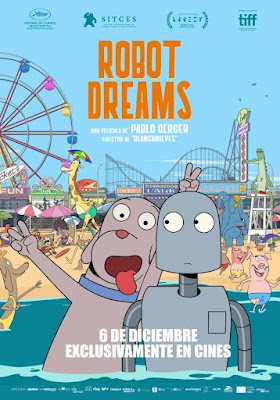An Academy Award-nominee for Best Animated Feature earlier this year (overshadowed by Hayao Miyazaki's The Boy and the Heron and Sony's Spider-Man: Across the Spider-Verse), this Spanish production from director Pablo Berger (with distribution by indie studio Neon) wasn’t released in North America until this summer.
The story takes place in New York City in the early-1980s, in a world of anthropomorphic animals. The main character is a lonely dog who comes across a commercial for companion robots one night, and decides to order one for himself. What happens next is really something—and more than just the titular "Tin Man" being fascinated by everything he sees.
Robot Dreams is essentially a silent picture, full of color, sound, and life. While there’s no dialogue per se, its auditory soundtrack naturally (and cleverly) fits the true nature of a world of animals. One of the film’s centerpieces has the main characters skate dancing to “September” by Earth, Wind & Fire. (The playlist of songs throughout is very nice as well.)
It’s also serves as a time capsule of the Big Apple, with the Twin Towers of the World Trade Center playing significantly in the background. Another truly mesmerizing sequence pays homage to The Wizard of Oz, with NYC as the Emerald City and a field of flowers doing an impressive tap number (perhaps the biggest floral dance routine since Fantasia). Robot even steps out of the frame--literally--during this segment, until it comes tumbling down. Coney Island also plays a key role into the story’s second act, as Dog unintentionally leaves a rusted Robot (a result of swimming) at the beach and is forced to wait until the following summer when the place reopens.
This is a charming and bittersweet story that spans every season over the course of one year. The result is a deeper journey than you might expect. Which begs the question: is this a film for children? The answer: yes and no. While Robot Dreams certainly has an eye-popping aesthetic and fantastical elements that will easily appeal to kids (the birds who first see Robot come to life are cute), its themes are more for the adult demographic. It’s also not afraid to hit us with doses of reality, including feelings of loneliness, neglect, and apathy. In a way, the film stands shoulder to shoulder with Wes Anderson’s take on Roald Dahl’s Fantastic Mr. Fox and Spike Jonze’s version of Maurice Sendack’s Where the Wild Things Are. It also reminded me of Kelly Reichardt’s film, Wendy and Lucy, about the relationship (and separation) between a woman and her dog.
While no language or sexual content issues are present (although, one scene plays with the notion of animals wearing or not wearing clothes, something that Disney’s Zootopia poked fun at as well), there is a brief moment earlier in the film where street hoodlums give some middle fingers, while Robot mistakes them for friendly gestures. When Robot is stuck at the beach, Dog tries several times to break him out, only to be arrested and jailed, and leaving him no choice but to wait for months and months. During a Halloween montage, Dog dresses as a vampire, using ketchup as fake blood. Some of the trick’r’treaters include the twins from The Shining and Freddy Kruger. Dog is even seen reading King's novel Pet Cemetery. Brief smoking and some heartbreaking elements involving a pawn shop are present as well. One bizarre sequence involves a snowman and a penguin at a bowling alley, drinking slurpies. It should also be noted that the friendship between Dog and Robot is a platonic one. Still, parents should make the decision before letting their kids see this film.
I did wonder, at times, what Robot Dreams was saying about our current culture, about human relationships or the lack thereof (one scene finds Dog going on a ski trip and unsuccessfully trying to make new friends), and the issue of artificial intelligence (turning to things for value and companionship, similar to Jonze's film Her?).
There are, however, other touching moments, like a mother bird raising her three babies (one of them being the outcast). This is one of the film's many visual metaphors of starting anew. (Wait until you see the character Rascal.) It’s a life-affirming message that things may not go as we plan them to, but we can still live, and always remember those moments with the ones we love. As for relationships and/or friendships, they may start with a spark, and last for a moment or a season or so. But sometimes, they may not be meant for each other or for the long run. But that’s okay. And it’s those themes and daring directions that make this an underrated gem worth checking out. Again, it’s really something.





No comments:
Post a Comment